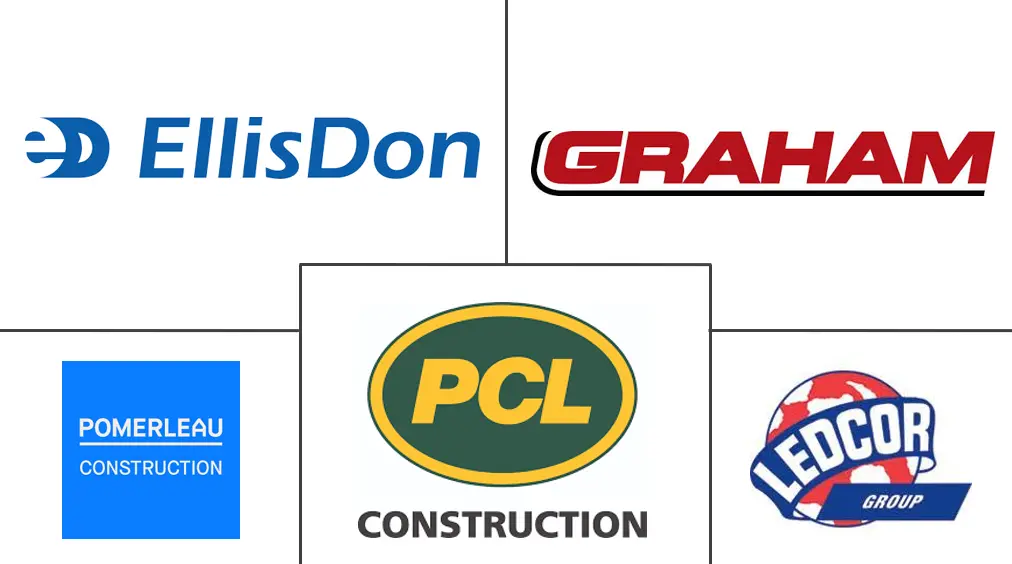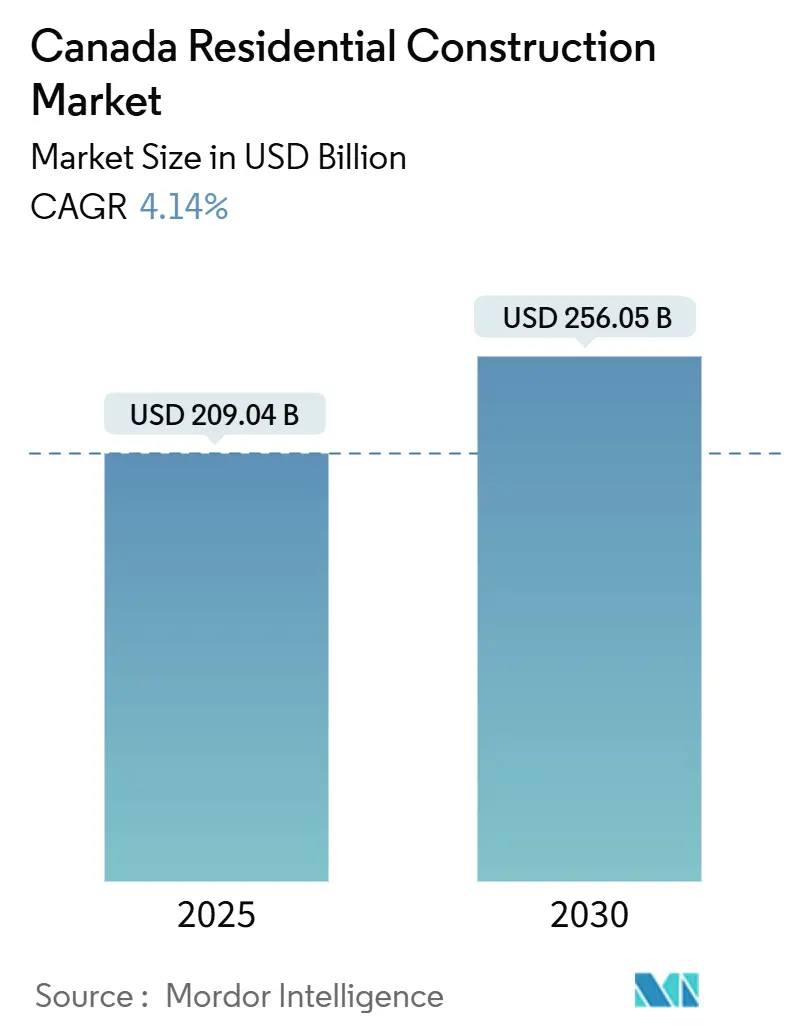
Canada Residential Construction Market Analysis by Mordor Intelligence
The Canada Residential Construction Market size stands at USD 209.04 billion in 2025 and is forecast to reach USD 256.05 billion in 2030, reflecting a steady 4.14% CAGR through the period. Demand is powered by record immigration inflows, generous federal incentives, and widening adoption of prefabrication that offsets skilled-labor scarcity. Housing programs such as the Apartment Construction Loan Program and expanded GST rebates lower developer financing costs and boost buyer affordability, encouraging faster delivery of rental and entry-level units. Rapid urban population growth in Toronto, Vancouver, Montreal, and Calgary anchors high-rise activity, while suburban centers capitalize on land availability to attract villa and landed house construction. Technology investment accelerates site productivity, yet material inflation and lengthy approvals temper the pace at which new supply reaches the market.
Key Report Takeaways
- By type, apartments and condominiums led with 56.56% of the Canada residential construction market share in 2024; villas and landed houses are projected to expand at a 6.42% CAGR through 2030.
- By construction type, new construction accounted for 70.56% of the Canada residential construction market size in 2024, while renovation is advancing at a 5.71% CAGR to 2030.
- By construction method, conventional on-site building maintained an 82.45% share in 2024, whereas modern methods of construction are forecast to grow at a 7.30% CAGR through 2030.
- By investment source, private funding dominated with 92.56% of the Canada residential construction market size in 2024; public investment is rising at a 7.10% CAGR on the back of affordable housing initiatives.
- By geography, Toronto held 29.40% of the Canada residential construction market share in 2024, and Calgary posts the fastest 6.20% CAGR through 2030.
Canada Residential Construction Market Trends and Insights
Drivers Impact Analysis
| Driver | (~) % Impact on CAGR Forecast | Geographic Relevance | Impact Timeline |
|---|---|---|---|
| Government support & housing incentives | +1.2% | National, with concentrated benefits in Toronto, Vancouver, Montreal | Medium term (2-4 years) |
| Immigration-led demand surge | +0.9% | National, with early concentration in Toronto, Vancouver gateway cities | Long term (≥ 4 years) |
| Population growth & urban in-migration | +0.8% | Toronto, Vancouver, Calgary, Montreal corridors | Long term (≥ 4 years) |
| Low-interest mortgage environment | +0.6% | National, with higher sensitivity in high-cost markets | Short term (≤ 2 years) |
| Labor-saving construction tech adoption | +0.4% | British Columbia, Ontario early adopters, expanding nationally | Medium term (2-4 years) |
| Climate-resilience retrofits demand in coastal zones | +0.3% | British Columbia, Atlantic provinces, Great Lakes regions | Long term (≥ 4 years) |
| Source: Mordor Intelligence | |||
Government Support and Housing Incentives
Federal measures are rewriting construction economics by blending low-cost credit with targeted tax relief. The Housing Accelerator Fund has signed agreements sufficient for more than 750,000 homes, while the Apartment Construction Loan Program channels USD 15 billion in loans toward 30,000 rental units. Thirty-year amortizations for first-time buyers of new homes cut monthly payments by 11%, making freshly built units relatively more affordable than resale properties. Complete GST/HST rebates on purpose-built rentals improve developer cash flow and offset rising input costs. Savers now access tax-free Home Savings Accounts and higher RRSP withdrawal ceilings that enlarge down-payment pools. Together, these tools create a virtuous demand loop that lifts the Canada residential construction market while sending clear signals for capacity expansion.
Immigration-Led Demand Surge
Canada maintains the highest per-capita immigrant intake among advanced economies, which pushes baseline housing demand above historical norms. Enhanced GST rebates for residential rentals and competition-law updates encourage swift housing creation, whereas a temporary ban on foreign homebuyers preserves existing inventory for residents. CMHC estimates 5.8 million additional homes are needed by 2030 to restore affordability, with immigration driving 60% of the gap. Settlement patterns cluster in Toronto, Vancouver, and Calgary, widening regional imbalances. Newcomers prioritize rental tenure, transit proximity, and community amenities, guiding developers toward higher-density formats and integrated neighborhood design.
Population Growth and Urban In-Migration
Aggressive immigration targets of 485,000 permanent residents a year reshape demand geography and scale, with 87% of newcomers settling in four main corridors. Strong inflows elevate rental absorption and spur multi-family starts in the urban core. Statistics Canada notes immigrants already make up nearly one quarter of residential contractors, adding supply-side depth even as they fuel demand. Municipalities respond by easing density limits; Vancouver’s multiplex program halves processing time, while Downsview West District in Toronto will deliver 8,800 homes near rapid transit. Sustained demographic momentum underpins long-term investment plans, yet concentration in select metros intensifies infrastructure stress and land-price escalation[1]BC Housing, “Mobilizing Building Adaptation and Resilience,” bchousing.org.
Low-Interest Mortgage Environment
The Bank of Canada’s rate cuts trim funding costs for both buyers and builders. Toronto home sales rose 44.4% year over year after the first cut, demonstrating immediate sensitivity on the demand side. Developers revived projects shelved during the tightening cycle; Medallion Corporation moved ahead with 1,500 rental units across the Greater Toronto Area under favorable debt terms. Rental projects gain the most, since stable cash flows align with lender preferences. Extended amortizations available only on newly built homes further divert buyers from the resale pool to the fresh supply. Yet if inflation rebounds, rate relief could reverse, exposing highly leveraged projects to refinancing risk beyond 2026.
Restraints Impact Analysis
| Restraint | (~) % Impact on CAGR Forecast | Geographic Relevance | Impact Timeline |
|---|---|---|---|
| Escalating material & labor costs | -0.7% | National, with acute impacts in remote and high-growth regions | Short term (≤ 2 years) |
| Lengthy municipal zoning/approval cycles | -0.5% | Toronto, Vancouver, Montreal regulatory bottlenecks | Medium term (2-4 years) |
| Skilled-labor attrition due to retirements | -0.4% | National, with concentrated impacts in Ontario, Quebec, British Columbia | Long term (≥ 4 years) |
| Strain on transmission/grid capacity for all-electric builds | -0.3% | British Columbia, Ontario urban centers, Quebec high-density areas | Medium term (2-4 years) |
| Source: Mordor Intelligence | |||
Escalating Material and Labor Costs
Input prices continue to climb, squeezing contractor margins and delaying project launches. Raw materials rose 4.7% from February to March 2024, with lumber up 7.8% as demand collides with tariff-driven scarcity. Construction costs in Toronto spiked 15.3% by late 2021 and show no sign of reverting, an escalation attributed to supply-chain kinks and energy-price volatility. U.S. tariffs on Canadian steel and aluminum raise product costs by 25%, compelling developers either to renegotiate budgets or postpone starts. Labor charges grow 4–6% annually, while 22% of workers are near retirement, fueling bidding wars for skilled trades. Each percentage point rise erodes affordability and redirects some buyers to the existing-home market.
Lengthy Municipal Zoning and Approval Cycles
Processing delays translate into financing drag and cost overruns. Average approval times of 20.3 months in the Greater Toronto Area add USD 43,000 to USD 90,000 per new dwelling, depressing feasibility for affordable projects. Edmonton’s multi-unit permits require 181 days, far beyond its 90-day objective, a lag intensified by staff shortages and rising application complexity. Vancouver’s new multiplex stream aims to cut waits by half, and Ontario’s 2024 Building Code eliminates 1,730 technical variations to sync with national standards. Quebec’s Bill 51 loosens regional certification rules to increase labor mobility, yet uneven adoption keeps paperwork heavy. While digital portals promise future efficiency, near-term bottlenecks persist and cap the supply response that the Canada residential construction market needs for balance.
Segment Analysis
By Type: Condominiums Anchor Urban Growth
Apartments and condominiums captured the largest 56.56% share of the Canada residential construction market in 2024. Their dominance springs from zoning policies that incentivize vertical density and from buyer preference for managed amenities close to employment hubs. The segment’s scale also reflects federal rental incentives and strong investor appetite for cash-flow assets in gateway cities. Developers such as Concord Pacific push the skyline higher with the 5,000-unit Concord Landing plan in Vancouver, while Toronto witnesses brisk rental tower pipelines around future Ontario Line stations.
Villas and landed houses, although smaller today, register the fastest 6.42% CAGR through 2030. Growth concentrates in suburban Calgary, Edmonton, and secondary markets where land stays relatively affordable and municipal taxes remain competitive. Energy-sector recovery boosts disposable income in Alberta, encouraging single-family builds that feature larger footprints and attached home offices. Builders leverage prefabricated wall panels to curb labor risk and maintain delivery schedules. As a result, single-family inventory expands without derailing the overall densification trajectory of the Canada residential construction market.
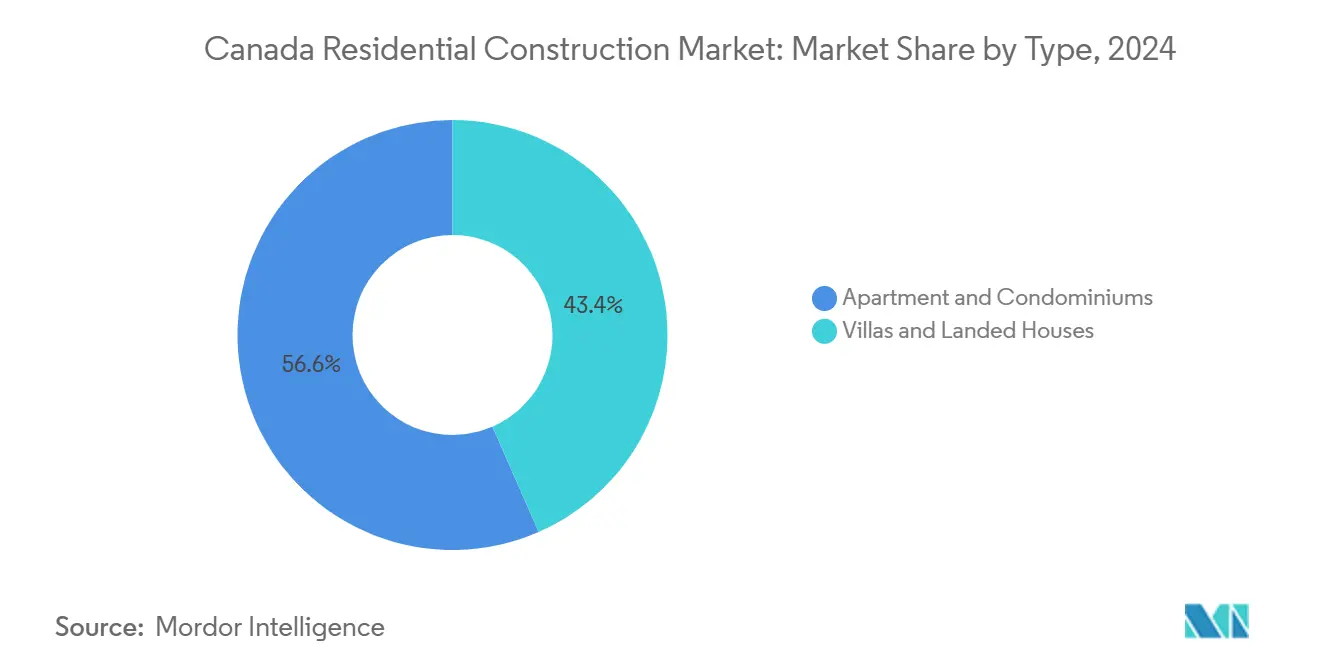
Note: Segment shares of all individual segments available upon report purchase
By Construction Type: New Builds Still Rule but Renovation Gains Traction
New construction dominated 70.56% of the Canada residential construction market size in 2024, a position enhanced by incentives exclusive to newly built homes. Thirty-year amortizations and full GST rebates tip buyer calculus toward new units, while immigrant families seeking larger households gravitate to purpose-built rentals. Developers prioritize shovel-ready sites near transit nodes to maximize absorption speed and meet lender covenants.
Renovation posts a healthy 5.71% CAGR fueled by aging stock, energy-efficiency mandates, and climate resilience upgrades. The Canada Greener Homes program and provincial tax credits underwrite deep retrofits that lower utility bills and carbon output. Quebec expects USD 14.8 billion in residential renovation outlays in 2025, powered by Bill 16 rules that require detailed maintenance plans for condominiums. Contractors skilled in heat-pump installation, floodproof basements, and wildfire-resistant cladding benefit from rising homeowner awareness. This retrofit wave complements but does not displace new supply, together expanding the Canada residential construction market.
By Construction Method: Conventional Dominates While Modern Methods Accelerate
Conventional on-site building maintained an 82.45% share in 2024, grounded in established supply chains and local labor familiarity. Provincial codes historically favored stick-built techniques, and lenders’ risk models align with traditional sequencing. Contractors deploy incremental digital tools, drones, and 4D scheduling to squeeze marginal gains yet still rely on trade-oriented workflows that limit scale.
Modern Methods of Construction surge at a 7.30% CAGR as chronic labor shortages and compressed timelines encourage prefabrication. Federal loan pools of USD 500 million for modular rental towers shorten financial close, and provinces pilot expedited permitting for certified off-site systems. Bird Construction’s acquisition of Jacob Bros adds modular expertise, while Horizon Legacy’s robotic assembly site proves automation can deliver stacked townhouses with 20% energy intensity reduction. Wider adoption awaits harmonized codes and lender comfort, but the cost and speed advantages are now too tangible for builders to ignore in the Canada residential construction market.
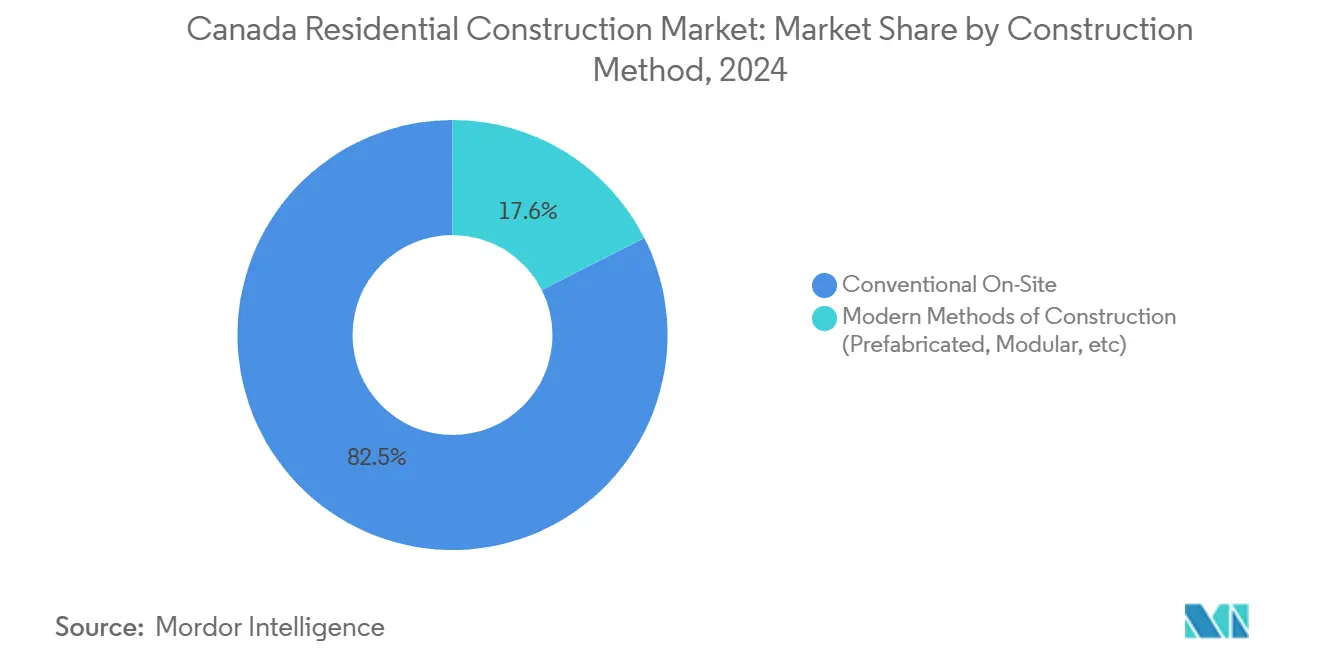
By Investment Source: Private Capital Leads With Public Support Rising
Private investors provided 92.56% of total funding in 2024. Their dominance stems from abundant domestic pension capital, low interest expense, and a policy philosophy that channels subsidies rather than direct construction. Equity and debt flows concentrate in gateway cities where absorption certainty offsets narrow profit margins. Large developers hedge rate risk through fixed-cost modular contracts and forward-purchase agreements with institutional landlords.
Public investment grows 7.10% annually as affordability gaps widen. The Affordable Housing Fund drew USD 1 billion more in Budget 2024, the Rapid Housing Initiative secures USD 4 billion, and USD 1.6 billion targets Indigenous housing. Municipalities also deploy land contributions and fee waivers to tilt pro formas toward social objectives. While public spending remains a minority, its strategic direction shapes land use and catalyzes blended finance that enlarges the Canada residential construction market[2]Horizon Legacy Group, “Automated Neighborhood Press Release,” horizonlegacy.ca.
Geography Analysis
Toronto anchors national construction output with a 29.40% share, underpinned by comprehensive transit investment, corporate headquarters density, and tailored federal incentives for high-cost regions. Nevertheless, approval lead times averaging 20.3 months inflate project costs by up to USD 90,000 per unit, compelling developers to front-load contingency budgets and favor modular elements that can be assembled off-site while paperwork proceeds. Immigrant arrival rates, stable tech employment, and infrastructure such as the Ontario Line assure long-run demand, sustaining premium pricing despite elevated carrying costs.
Vancouver combines a constrained land supply with regulatory reforms aimed at speeding multiplex approvals by 50%. Concord Pacific’s 5,000-home project adjacent to dismantled viaducts exemplifies the city's ambitions to unlock underused parcels. Rental demand fueled by international students and knowledge-sector jobs supports dense podium-tower formats. Meanwhile, Montreal benefits from Bill 51 labor flexibility, which lowers trade costs and lifts housing starts toward 44,000 units, marking 13% annual growth.
Beyond the Big 3, Calgary emerges as the fastest-growing metro, posting a 6.20% CAGR as energy services rebound and diversified employers recruit talent priced out of coastal cities. Federal and provincial programs dedicate funds to rural and Indigenous communities, broadening construction activity to Atlantic Canada and the Prairie provinces. Natural Resources Canada finances climate adaptation work in Atlantic coastal towns, complementing Saskatchewan’s USD 18 million skilled-trades campus that propels housing starts in secondary centers. Together, these forces extend the footprint of the Canada residential construction market beyond its traditional urban strongholds.
Competitive Landscape
The Canada residential construction market is moderately fragmented, with a moderate percentage of the output generated by firms employing fewer than five workers. Small contractors compete on price but struggle to scale digital site management and modular investments. Productivity gains thus lag peer nations, keeping cost inflation sticky and rendering consolidation attractive.
Larger players pursue mergers and alliances to capture economies of scale. Bird Construction’s USD 125 million purchase of Jacob Bros augments regional presence in British Columbia infrastructure and deepens modular credentials. Pomerleau teamed with Aecon and ACCIONA to secure the USD 928 million Surrey Langley SkyTrain stations package, leveraging joint capabilities in complex rail contracts. Such consortium bidding shifts risk profiles but positions participants for pipeline visibility that supports workforce retention.
Technology innovators carve niches by automating repetitive tasks. Horizon Legacy’s robotics neighborhood demonstrates 30% affordable-unit inclusion at lower energy intensity, proving that automated framing and cladding can sync with Canadian codes. Aecon partners with Concordia University to test low-carbon concrete at its Training and Innovation Centre, signaling an R&D emphasis as carbon prices loom. Government modular loans and code harmonization further level entry barriers, setting the stage for accelerated adoption and potential shake-out among lagging contractors in the Canada residential construction market[3]Pomerleau Inc., “Surrey Langley SkyTrain Contract Award,” pomerleau.ca.
Canada Residential Construction Industry Leaders
-
PCL Construction
-
EllisDon Corporation
-
Graham Construction
-
Ledcor Group of Companies
-
Pomerleau Inc.
- *Disclaimer: Major Players sorted in no particular order
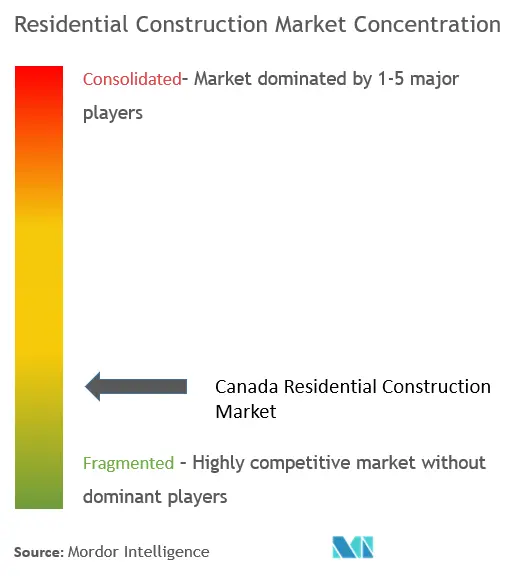


Recent Industry Developments
- January 2025: Canada Lands Company filed the Downsview West District Plan in Toronto, adding 8,800 homes with 20% reserved as affordable and targeting net-zero operational emissions by 2040.
- January 2025: Pomerleau ranked in the ReNew Top 100 Projects Report with 18 projects, nearly USD 5 billion in 2023 revenue, and highlighted subsidiary ITC as a leading Western Canadian residential builder.
- January 2025: Ontario implemented the 2024 Building Code, aligning provincial rules with the national code and stripping 1,730 variations to reduce compliance overhead.
- October 2024: Morguard broke ground on a 431-unit rental community in Mississauga designed for LEED Gold certification with rainwater capture and heat-recovery ventilation.
Canada Residential Construction Market Report Scope
Residential construction is a process that involves the expansion, renovation, or construction of a new home or spaces intended to be occupied for residential purposes. These structures range from single-family homes and multi-family units to townhouses, condominiums, and apartment buildings. The Canadian residential construction market is segmented by type (apartments/condominiums and villas/landed houses), and by key city (Edmonton, Calgary, Toronto, Vancouver, Ottawa, Montreal, and Rest of Canada). The Report Offers Market Sizes (USD) and Forecasts for all the Above Segments.
| Apartment & Condominiums |
| Villas and Landed Houses |
| New Construction |
| Renovation |
| Conventional On-Site |
| Modern Methods of Construction (Prefabricated, Modular, etc) |
| Public |
| Private |
| Toronto |
| Vancouver |
| Montreal |
| Calgary |
| Rest of Canada |
| By Type | Apartment & Condominiums |
| Villas and Landed Houses | |
| By Construction Type | New Construction |
| Renovation | |
| By Construction Method | Conventional On-Site |
| Modern Methods of Construction (Prefabricated, Modular, etc) | |
| By Investment Source | Public |
| Private | |
| By Geography | Toronto |
| Vancouver | |
| Montreal | |
| Calgary | |
| Rest of Canada |


Key Questions Answered in the Report
How big is the Canada residential construction market in 2025?
The Canada residential construction market size is USD 209.04 billion in 2025, rising to USD 256.05 billion by 2030.
What is driving near-term housing demand?
Record immigration, supportive mortgage policy, and targeted federal incentives combine to lift demand in major metropolitan areas.
Which city will grow the fastest by 2030?
Calgary shows the highest projected growth with a 6.20% CAGR through 2030 as migration and energy diversification fuel starts.
Are modern construction methods gaining traction?
Yes, modular and prefabricated approaches are expanding at a 7.30% CAGR as developers seek labor savings and faster delivery.
How are rising material costs affecting projects?
Material inflation of up to 7.8% on key inputs and 4–6% labor growth squeezes margins and causes some developers to delay or re-price projects.
What role does government play in affordable housing?
Public programs such as the Rapid Housing Initiative and Affordable Housing Fund inject capital and policy support, while still relying on private builders for execution.
Page last updated on:
